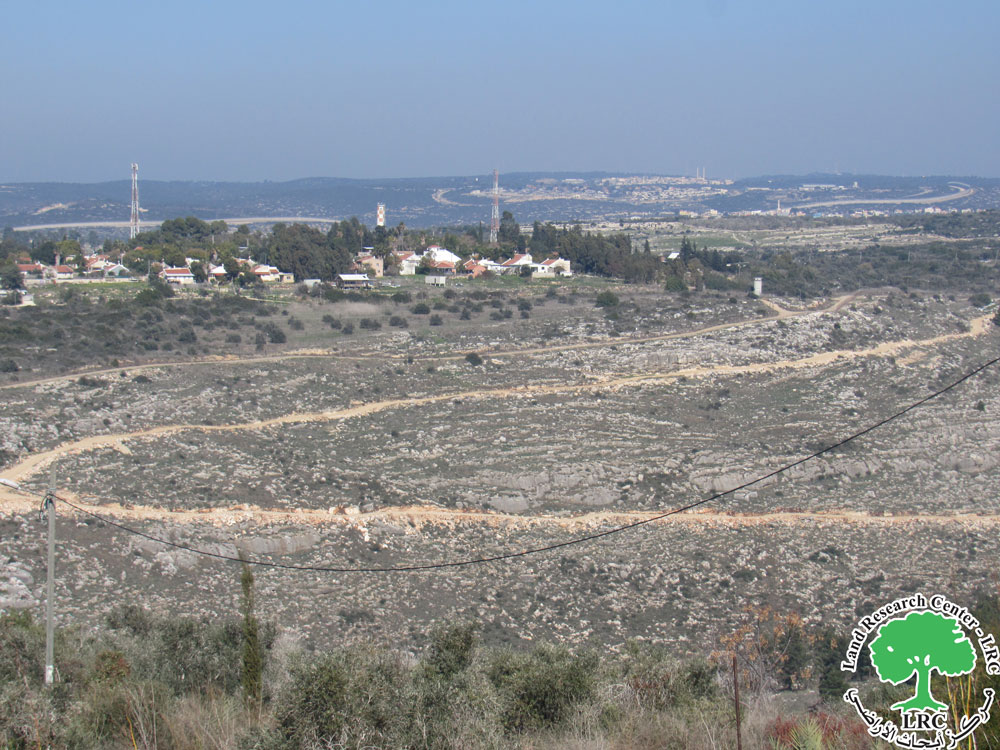Colonial Road Construction on the Lands of An Nazla ash Sharqiya Village and Closure of Agricultural Lands / Tulkarem Governorate
Violation: Settler attacks on the village's lands.
Location: An Nazla ash Sharqiya village / North of Tulkarem.
Date of Violation: Early January 2025.
Perpetrator: "Hermesh" settlement.
Impacted Farmer: Residents of An Nazla ash Sharqiya village.
Description:
The Israeli occupation continues to tighten restrictions on farmers in An Nazla ash Sharqiya village, located to the north of Tulkarem Governorate, where the village directly faces daily attacks from settlers living in the "Hermesh" settlement.
Construction of a New Colonial Road:
It is noted that the Israeli occupation has started, over the past few months, to construct a new colonial road connecting the "Hermesh" settlement, located north of An Nazla ash Sharqiya, to the new colonial outpost there, built within the forested areas at the edges of the village’s lands. The road has reached a length of approximately 2 kilometers so far, and it is being constructed on land that the Israeli occupation classifies as "state land."
a view of the colonial street
The danger of this road lies in the fact that it passes through an area that was previously used as grazing land for livestock. Moreover, it effectively closes off the entire northern part of the village in a tight manner. Since October 7, the occupation has prevented farmers and livestock breeders from being present or utilizing these lands.
Mr. Wael Kattana, Head of the An Nazla ash Sharqiya Village Council, stated:
"Since the construction of this road, we, the residents of the village, numbering 3,000 people, have been in a constant state of daily concern. The settlers are now very close to our homes because of this road, which passes no more than 200 meters from the nearest house. The road cuts through a vast area of grazing land, effectively threatening no less than 400 dunams of land."
On the other hand, there are concerns that the settlers may in the future expand the Hermesh settlement onto the land the road passes through, especially since most of it is classified as state land, which means the area controlled by the settlement would be significantly increased.
Closure of Olive Grove Lands:
The settlers placed an iron gate at the edges of this road constructed by the occupation, and they alone control when to open and close it. This action has deprived farmers of access to approximately 70 dunams of land planted with fruitful olive trees. As a result, they have been unable to harvest the olive crop due to the gate, armed threats, and continuous harassment from settlers. At least ten farmers have been affected, as they have been prevented from entering their lands located to the east of the village in an area known as " Tahr Al-Burayda ".
Photo of Metal gate sat up by illegal Colonists
Establishment of a New Colonial Outpost:
As part of the ongoing colonial assault, the settlers established a new outpost in the forested area known as "Al-Sunbula" to the northeast of the village. This outpost includes a metal shack and three mobile units, covering an area of three dunams of land, which the occupation classifies as a nature reserve.
This outpost is connected to the Hermesh settlement to the north through the new colonial road, with only a one-kilometer distance separating them. The danger of this outpost lies in its proximity to the village homes, as it is located just 150 meters away, which has raised significant concerns among the residents and instilled serious fears regarding their daily lives.
the new colonial outpost
Mr. Fayez Khaled Kattana, a resident of the neighborhood near the outpost, stated:
"Since the establishment of the outpost, the occupation army has been constantly present in the village. We have been threatened with the demolition of any new house or any expansion of existing homes, which has restricted our lives because of these settlers."
Hermesh Settlement:
It is worth noting that the Hermesh settlement was established in 1980 on land classified by the occupation as state land, which originally belongs to the villages of Qaffin, An Nazla ash Sharqiya, and Al-Nazlah Al-Wusta, located to the north of Tulkarm city. The settlement's population was approximately 300 people as of 2018.




